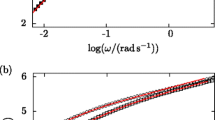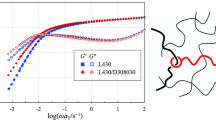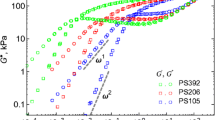Abstract
We investigated the stress relaxation behavior of critical gels originating from six nearly monodisperse, highly entangled polybutadiene melts of different molecular weight from 18000 to 97 000 g/mole. The polymers were vulcanized by a hydrosilation reaction which takes place nearly exclusively at the pendant 1,2-vinyl sites distributed randomly along the polybutadiene chain. The BSW spectrum represents the relaxation of the initial uncrosslinked precursor. A characteristic parameter is the longest relaxation time of the precursor. Crosslinking increases this longest time even further. Surprisingly, the relaxation spectrum of the precursor is not altered much by the crosslinking except for an additional long time behavior. At the gel point (critical gel), this long time behavior is self-similar. It follows the typical power law as described by the Chambon-Winter gel equation, G(t) = St −n, in the terminal zone. The critical relaxation exponent was found to be close to n = 0.5 over a range of stoichiometric ratios and for all precursor molecular weights analyzed. A new scaling relationship was found between the gel stiffness, S, and the precursor molecular weight of the form: S ∼ M zn w , where exponent z from the zero shear viscosity-molecular weight relationship, η0 ∼ M z w , is commonly found to be z = 3.3 – 3.6.
Similar content being viewed by others
References
Adolf D, Martin JE (1990) Time-cure superposition during cross-linking. Macrom 23:3700–3704
Aranguren MI, Macosko CW (1988) Modulus of polybutadiene networks made by hydrosilation cross-linking. Macrom 28:2484–2491
Baumgaertel M, Winter HH (1989) Determination of discrete relaxation and retardation time spectra from dynamic mechanical data. Rheol Acta 28:511–519
Baumgaertel M, De Rosa ME, Machado J, Masse M, Winter HH (1992) The relaxation time spectrum of nearly monodisperse polybutadiene melts, Rheol Acta 31:75–82
Baumgaertel M, Schausberger A, Winter HH (1990) The relaxation of polymers with linear flexible chains of uniform length. Rheol Acta 29:400–408
Baumgaertel M, Winter HH (1992) Interrelation between continuous and discrete relaxation time spectra. J NonNewt Fluid Mech 44:15–36
Berry GC, Fox TG (1968) The viscosity of polymers and their concentrated solutions. Adv Polym Sci 5:261–357
Chambon F, Winter HH (1985) Stopping of crosslinking reaction in a PDMS polymer at the gel point. Polym Bull 13:499–503
Chambon F (1986) Linear viscoelasticity of crosslinking polymers at the gel point. Ph D Thesis, University of Massachusetts, Amherst, MA
Chambon F, Petrovic ZS, MacKnight WJ, Winter HH (1988) Rheology of model polyurethanes at the gel point. Macrom 19:2146–2149
Chambon F, Winter HH (1987) Linear viscoelasticity at the gel point of a crosslinking PDMS with imbalanced stoichiometry. J Rheol 31:683–697
Colby RH, Fetters LJ, Funk WG, Graessley WM (1991) Effects of concentration and thermodynamic interaction on the viscoelastic properties of polymer solutions. Macrom 24:3873–3882
Colby RH, Fetters LJ, Graessley WW (1987) Melt viscositymolecular weight relationship for linear polymers. Macrom 20:2226–2237
de Gennes PG (1976) Dynamics of entangled polymer solutions. I. The Rouse model. Macrom 9:587–593
de Gennes PG (1976) Dynamics of entangled polymer solutions. II. Inclusion of hydronamic interactions. Macrom 9:594–598
De Rosa M, Winter HH (1993) Determination of the gel point of highly entangled polymers of high molecular weight. ANTEC Conf Proc vol III, 2620–2626
Doi M, Edwards S (1986) The theory of polymer dynamics. Clarendon Press, Oxford
Dossin LM, Graessley WW (1979) Rubber elasticity of well-characterized polybutadiene networks. Macrom 12:123–130
Ferry JD (1980) Viscoelastic properties of polymers, 3rd ed. John Wiley and Sons Inc, New York
Fischer A, Gottlieb M (1986) Side reactions in the endlinking of PDMS networks. Proc of Networks 86, Elsinor Denmark
Flory PJ (1953) Principles of polymer chemistry. Cornell University Priss, Ithaca, New York
Friedmann G, Brossas J (1985) Synthesis of statistical networks with liquid polybutadiene and telechelic bishydrogenosilyl coupling agents. Polym Prepr 26:268–269
Graessley WW (1974) The entanglement concept in polymer rheology. Adv in Polym Sci, vol 16
Holly EE, Venkataraman SK, Chambon F, Winter HH (1988) Fourier transform mechanical spectroscopy of viscoelastic materials with transient structure. J NonNewt. Fluid Mech 17:17–26
Isono Y, Fugimoto T, Takeno N, Kjiura H, Nagasawa M (1978) Viscoelastic properties of linear polymers with high molecular weights and sharp molecular weight distributions.Macrom 11:888–893
Izuka A, Winter HH, Hashimoto T (1992) Molecular weight dependence of viscoelasticity of polycaprolactone critical gels. Macrom 25:2422–2428
Jackson J, De Rosa M, Winter HH (1994) Molecular weight dependence of relaxation time spectra for the entanglement and flow behavior of monodisperse linear flexible polymers. Macrom 27:2426–2431
Kauffman GB, Cowan DO (1960) In: Rochow EG (ed) Inorganic syntheses, Vol. 6.. Cis and trans-dichlorobis(diethyl sulfide) platinum (II). Mc Graw-Hill, New York, p 211–215
Lairez D, Adam M, Emery JR, Dugand D (1992) Rheological behavior of an epoxy/amine system near the gel point. Macrom 25:286–289
Macosko CW, Saam JC (1987) The hydrosilation cure of polyisobutene. Polym Bull 18:463–471
Macosko CW (1985) Rheological changes during crosslinking. British Polymer Journal 17:239–245
Masuda T, Toda N, Aoto Y, Onogi S (1972) Viscoelastic properties of concentrated solutions of poly (methyl methacrylate) in diethyl phthalate. Polymer J 3:315–321
Miron J, Bhatt P, Skeist I (1973) Silane-modified polybutadienes. In: Recent advances in adhesion, Gordon and Breach Science: London, 309–315
Mours M, Winter HH (1994) Time resolved rheometry. Rheol Acta, to appear
Muller R, Gerard E, Dugand P, Rempp P, Gnanou Y (1991) Rheological characterization of the gel point: a new interpretation, Macrom 24:1321–1326
Nakagasu H, Fox TG (1960) Abstracts 137th meeting of Am Chem Soc p 11-I
Nemoto N, Ogawa T, Odani H, Kurata M (1972) Shear creep studies of narrow-distribution poly(cis-isoprene) III. Concentrated solutions. Macrom 5:641–644
Raju VR, Menezes EV, Marin G, Graessley WW, Fetters LJ (1981) Concentration and molecular weight dependence of viscoelastic properties in linear and star polymers. Macrom 14:1668–1676
Riande E, Markovitz H, Plazek DJ, Raghupathi N (1975) Viscoelastic behavior of polystyrene-tricresyl phosphate solutions. J Polymer Sci Polym Symp 50:405–430
Scanlan JC, Winter HH (1991) The evolution of viscoelasticity near the gel point of end-linking poly(dimethylsiloxane)s. Makromol Chem Macromol Symp 45:11–21
Scanlan JC, Winter HH (1991) Composition dependence of the viscoelasticity of end-linked poly(dimethylsiloxane) at the gel point. Macrom 24:47–53
Stockmayer WH (1943) Theory of molecular size distribution and gel formation in branched-chain polymers. J Chem Phys 11:45
Valentine RH, Ferry JD, Homma T, Ninomiya K (1968) Viscoelastic properties of polybutadienes — linear and lightly crosslinked near the gel point. J Polym Sci, A-2, 6:479–492
Watanabe H, Kotaka T (1984) Viscoelastic properties and relaxation mechanisms of binary blends of narrow molecular weight distribution polystyrenes. Macrom 17:2316–2325
Winter HH, Chambon F (1986) Analysis of linear viscoelasticity of a crosslinking polymer at the gel point. J Rheol 30:367–382
Winter HH (1987) Evolution of rheology during chemical gelation. Progr Colloid and Polym Sci 75:104–110
Winter HH (1989) Gel Point. In the encyclopedia of polymer science and engineering. Supplemental Volume, 2nd ed 343–351
Winter HH, Morganelli P, Chambon F (1988) Stoichiometry effects on rheology of model polyurethanes at the gel point. Macrom 21:532–535
Author information
Authors and Affiliations
Rights and permissions
About this article
Cite this article
De Rosa, M.E., Winter, H.H. The effect of entanglements on the rheological behavior of polybutadiene critical gels. Rheola Acta 33, 220–237 (1994). https://doi.org/10.1007/BF00437307
Received:
Revised:
Issue Date:
DOI: https://doi.org/10.1007/BF00437307




